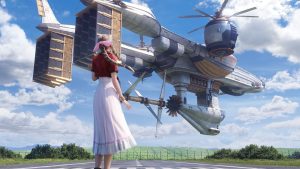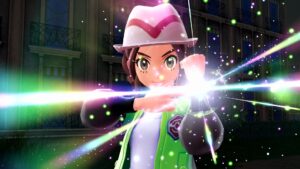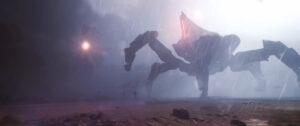
Mecha has been an underrated yet incredibly formative part of my life. The far-future yet grounded scenarios of Mobile Suit Gundam (not to mention all the sequels and spin-offs like Gundam 00, Iron-Blooded Orphans, The Witch from Mercury, etc.). The bombastic drama and twists of Code Geass. The over-the-top action and heart of Gurren Lagann. The anime sphere is simply rife with incredible stories and, above all else, robots, Knightmare Frames, Mobile Suits, etc. beating the tar out of each other.
Mecha Break attempts to channel all those disparate franchises, at least in terms of design. The almost non-existent narrative offers little more than set-up for a free-to-play competitive shooter with no shortage of objective-based modes, hero shooter elements, and, of course, an extraction mode. Its anime-inspired Strikers will certainly fulfill the fantasies of piloting your favorite mecha, pretending that you’re a New Type handling Trans-AM or a pilot deftly weaving between separate forms, even if it could use some further fine-tuning.
Even with all the mecha media I’ve consumed, I don’t think there’s ever been a set-up as blatantly disposable and forgettable as Mecha Break. The actual setting, clichéd as it sounds, with elements like The Catastrophe, the mysterious organisation S.H.A.D.O.W., and the magical MacGuffin Corite, which is actually poisoning the world. The whole race against time premise versus those following the “Corite’s call” is simply a means to explain why two different teams of players are fighting against each other.
"Though it can be very fast-paced, Mecha Break’s Energy system brings some strategy to the mix. You can fly, dash and boost through the air as long as your Energy lasts, but once it runs out, hitting the ground is a must to recharge."
And I would be fine with that if it imbued a little bit more soul into the game. You create a pilot from a decent set of customization tools, embark on the tutorial, and join S.H.A.D.O.W., but you’re ultimately irrelevant (even despite developer Amazing Seasun’s goal to make it feel like you’re more than just a mech). They’ll spout the same lines about sneaking into the backline if you’re playing as an Ambush Striker or telling an executed opponent to back off. No banter or chatter in combat. At least HQ is nice enough to give you a mission briefing (and let me mute them when I’ve heard it one too many times).
Such an approach could have primed the Strikers to have unique voice lines and personalities ala to the Titan OS voices from the Titanfall series. But alas.
On the bright side, Mecha Break does bring the ambience and immersion in many other important ways, including the actual piloting of the Strikers. Everything from the lift-off sequences to the fly-in adds to the fantasy, and some even have unique entrances – like starting underwater on a slowly rising elevator, which you can boost out of manually. Even the heads-up displays strike a fine balance between busy, as they should be, yet clean and clear-cut.
And though the inspirations for some of the Strikers are obvious – Alysnes is Gundam-coded, and Skyraider brings Macross to mind – they each have a distinct feel. Much of this boils down to granular specs like energy regeneration, defenses against various types of damage, fluid armor regeneration rate, mobility, handling, and much more. You’ll feel the heft of trying to get Stego into the air versus the sleekness of Falcon or even Stellaris.
I also appreciate how the Striker’s kit, despite slotting into a specific category – Support, Attackers, Flankers, Defenders – brings something notable to the table (though the viability of some can be argued). Falcon’s ability to pounce on and hound snipers is fantastic, but if you prefer a more generalist play style, Alysnes offers strong ranged and melee capabilities alongside an Airdrop Kit to rearm once its armor and shield have been destroyed.
Though it can be very fast-paced, Mecha Break’s Energy system brings some strategy to the mix. You can fly, dash and boost through the air as long as your Energy lasts, but once it runs out, hitting the ground is a must to recharge. Some Strikers have the benefit of remaining airborne for much longer; others are practically built for sticking to and maximising the benefits of terrain. Engaging targets and having enough wherewithal to retreat, using the environment to recover Energy while getting ready to go airborne again, is vital and can be as fun as it is frustrating when completely dry, awkwardly shuffling away as your fluid armor tanks the hits.
"Each map in Operation Verge offers a unique objective, whether it’s capturing and holding zones, delivering keys to a rocket launch or a payload race (which feels oddly more about capturing terminals than actually escorting)."
As diverse and unique as the Strikers feels, some balance issues need to be worked out. Ultra-Heavy Defenders like Stego can feel a little too difficult to take down than perhaps intended – yes, Ultra-Heavy Defender is literally in the name. However, a decent player can turtle, reposition, and unleash highly damaging shots at a consistent rate while staying alive. I also really like the playstyle for Stellaris – cloaking and stalking other Strikers before pouncing is fun in theory but a chore with how excessive the energy demands can be for such a melee and mobility-focused frame. The iffy melee hit registration also didn’t help, though it may have been lag in some cases. Some units like Skyraider could use a buff – its area of denial is only really helpful in theory.
Each map in Operation Verge offers a unique objective, whether it’s capturing and holding zones, delivering keys to a rocket launch or a payload race (which feels oddly more about capturing terminals than actually escorting). You also may partake in a straightforward deathmatch where the first team to reach eight kills wins the round in a best 2 out of 3. The various elevations and structures also lend a different flavor to fights, whether you’re fighting out in the open or scrapping in a close-knit hangar. While they can have some neat visual sights, very few felt really organic, even with dust storms rolling in or water levels rising and submerging an objective. It’s enough that they’re well-designed, but I wanted something more (even if it was a slightly higher skybox to avoid the annoying alerts about leaving the battlefield).
Aside from 6v6 battles, there’s Ace Arena, where two teams of three battle it out in a first to eight kills, single-round match. I actually had more fun with this than I thought, especially since you can switch out Strikers to adjust to the enemy’s strategy. Its maps are smaller and are once again well-designed, including one where engines would ignite and wall off areas with flame.
Mashmak is the third and final mode, offering a PvEvP extraction gameplay loop. The overarching map isn’t too shabby, though once again, the struggle to point out any distinct locations is real. At least there are several points of interest, enemy types and objectives to pursue, whether you’re destroying Corite Extractors, dodging storms or engaging with fleets. I mostly engaged in Free-For-All – matchmaking times for co-op were excessively long – and even if I can see it shining primarily with a team, it still offers this fun, looter-like loop of amassing a collection of mods, weapons and ammo, and slowly getting stronger.
Equipping a gatling gun and charged shot launcher to unload on enemies also felt great, though beware – there’s always a bigger Striker out there, ready to three-shot you. And while you can redeploy a limited number of times, once they take your loot, it’s gone (though acquiring cargo rockets to send loot back to base or setting your own extraction beacon can somewhat alleviate this). Being able to research better items, including Gliders, for some added firepower, also provides something to work towards, even if you need to locate their separate pieces on the battlefield.
"Mecha Break may not necessarily shake the foundations of competitive shooters, but it does offer something that very few can with its fast-paced mecha combat. There may be several areas to improve, but it’s a strong start and a solid foundation that will hopefully come into its own sooner than later."
There are multiple Strikers available from the get-go, but newcomers Stellaris and Serenith must be unlocked with Mission Tokens. You’ll get these through completing matches and missions as specific Strikers (which are like bounties) or Ace Conquest, which seems to be an introductory pass of sorts. However, picking up the Matrix Contract will boost gains across the board and even provide some free Cargo Rockets for Mashmak. With the new Strikers costing 15,000 Mission Tokens to unlock, the progression may need a bit of fine-tuning to ensure that free players aren’t grinding for too long to unlock a single new unit.
The Matrix Marketplace and Ace Recruitment, with pilots and unique variants of existing Strikers costing real money, also feel a little iffy, but we’ll only see how the former shakes out after launch. Features like a recruitment page for finding teams or customizing your pilot’s gestures during executions are pretty cool.
Mecha Break may not necessarily shake the foundations of competitive shooters, but it does offer something that very few can with its fast-paced mecha combat. There may be several areas to improve, but it’s a strong start and a solid foundation that will hopefully come into its own sooner than later.
This game was reviewed on PC.
Sleek visuals and presentation. Striker designs channel the most iconic anime while controlling exceptionally well and offering multiple options. Fast-paced and responsive combat. Strong selection of maps and modes with unique objectives and gameplay loops.
Feels somewhat soul-less with the set-up and lack of banter. Melee hit registration needs some more work. Maps lack any real sense of identity. Balance issues. The grind for new content may be annoying for those who don't purchase the Matrix Selections.


















